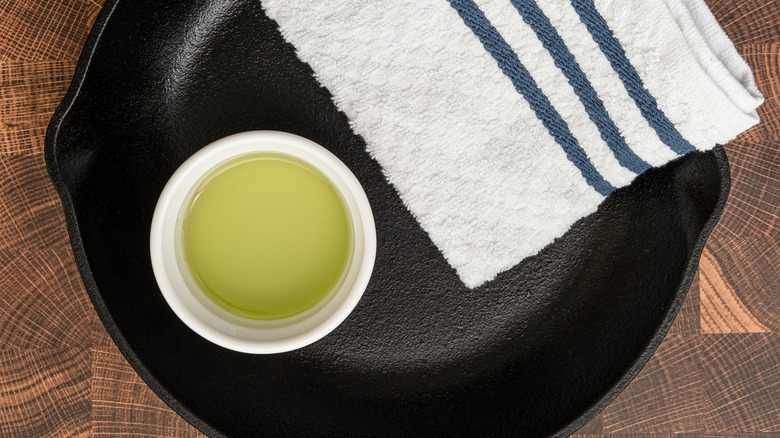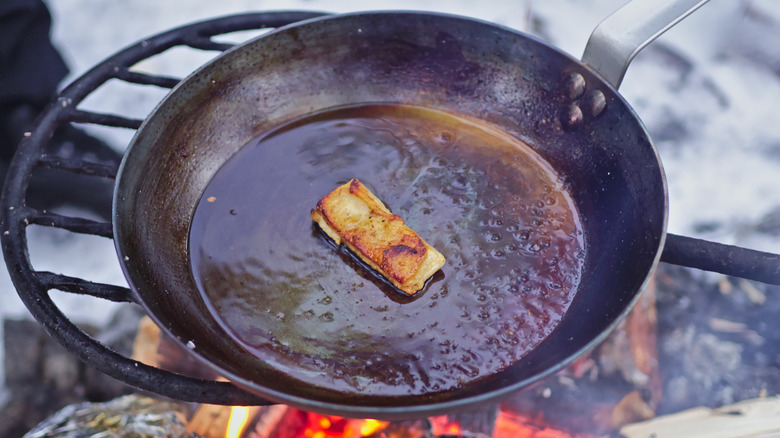The Best Way To Season A Carbon Steel Pan
If you think it might be time to buy new cookware, then you might be considering replacing your current pans with some carbon steel. Made In Cookware says that carbon steel is a great cooking material because it combines the best qualities of cast iron and stainless steel into a single package. Made In Cookware further explains that carbon steel is an alloy of mostly iron and carbon. The same combination is used to make cast iron pots and pans, but because it has a different ratio of the two materials, it is far lighter and easier to use.
Prudent Reviews adds that it has plenty of other positives as well. For example, carbon steel cookware has an extremely high heat tolerance. While most pans linger around 600 degrees Fahrenheit, some can tolerate cooking at temperatures as high as 800 or 1200 degrees. This makes them the go-to material for the best woks as well. In addition to sporting a quality level of heat tolerance, carbon steel cookware is also resistant to bumps, warping, and scratches as well. Not only will these pans serve you as great cooking surfaces, but they'll last a long time too.
Of course, if these pans are going to stay in great shape, they will need to be seasoned semi-regularly, and it's important to make sure it's done right.
What does it mean to season a pan?
When most people use the term "seasoning" in the kitchen, they're talking about what spices or herbs they'll put in their dish. When it comes to pans made from cast iron and carbon steel though, you're actually talking about building up a non-stick coating on the cookware's surface.
Lodge claims that the process of seasoning is done by carbonizing a cooking oil onto the metal surface of a pan. This is done through a chemical process known as polymerization. As the oils are heated on the surface of the pan, they form a chemical bond with the metal. This creates a non-stick surface that will build up over time and consecutive uses. That means that your carbon steel pans may seem like an investment at first, but if you keep in mind that their performance will only improve with age, you'll realize they're worth every penny.
Prudent Reviews points out that this also gives carbon steel an easy edge over non-stick cookware. After a non-stick surface is scratched or damaged on a Teflon surface, you can't do anything to fix that pot or pan. With a carbon steel pan though, all you'll need to do is re-season it, and it will be as good as new.
How to season carbon steel
Seasoning a carbon steel pan is a relatively easy task. Just One Cookbook says that the first thing to do is to clean the pan. Some manufacturers ship their carbon steel pans with a protective wax coating to avoid damaging the surface before you've gotten your hands on it. Removing this coating only requires a quick wash with a sponge and hot water.
Once it's been cleaned and dried, Cook's Illustrated says to add one-third cup of vegetable oil, two-thirds cup of salt, and some potato peels. You're not frying potato skins here though; the salt is meant to remove any extra grease or wax left behind on the surface, while the potato skins will moderate the heat in the pan. Seasoning without the potato skins can result in spotty seasoning, and may require multiple seasonings to even it out.
Put the pan and its contents over medium heat, and stir them every so often to cover the entire surface. Once the pan has started to turn brown, discard the contents and let the pan cool. Clean it gently, and return it to medium heat to let it dry completely. Made In Cookware says that cooking fatty foods like bacon in your pan early on will also help add to the thin layer of seasoning. If you notice that foods are starting to stick though, all you'll need to do is repeat the seasoning process to add another non-stick layer.


